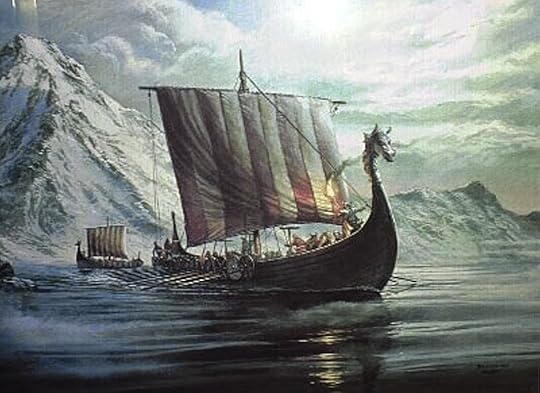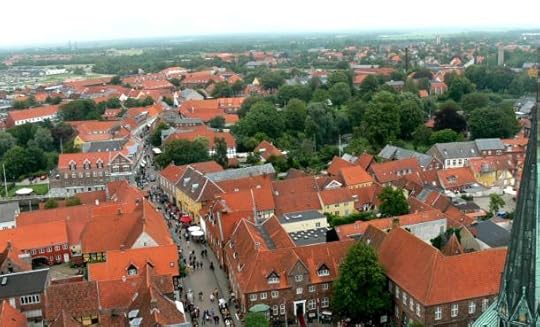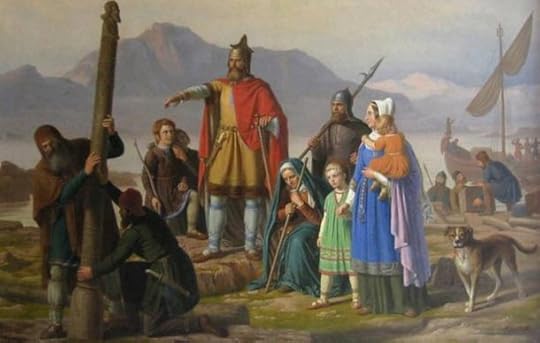Discovery of Reindeer Antlers in Denmark may Rewrite Start of Viking Age
 Ancient Origins
Ancient OriginsA team of scholars says their new research is rewriting when and where the Viking age began. The official date for the start of Viking voyages was a 793 AD raid in England. But researchers say people from Norway sailed to Ribe, Denmark, on peaceful missions much earlier—around 725 AD.
Archaeologists from the University of Aarhus in Denmark and the University of York in the United Kingdom found the useful commodity of Norwegian reindeer antlers buried in the earliest archaeological layer of Ribe’s old market. Ribe was the first commercial city in Denmark.
 This caribou with its magnificent rack in Alaska is the same species called reindeer in Scandinavia. (Photo by Dean Biggins/
Wikimedia Commons
)The sailing trips from Norway to Denmark helped the sailors establish the technology and skills necessary to do the later military raids and long-distance voyaging the Vikings did, they say.
This caribou with its magnificent rack in Alaska is the same species called reindeer in Scandinavia. (Photo by Dean Biggins/
Wikimedia Commons
)The sailing trips from Norway to Denmark helped the sailors establish the technology and skills necessary to do the later military raids and long-distance voyaging the Vikings did, they say.“Ultimately, the researchers agree that the discussion of when the Viking era began is also one of semantics,” says an article in ScienceNordic. “It all depends on what you mean by Vikings. Morten Søvsø from Southwest Jutland Museums suggests that we should be careful with the labels we give to people who lived in the past. ‘They didn’t go around knowing they were Vikings. If you want to argue that the Viking age in fact started when they had contact with the wider world, then this study supports this view—but it will always be a rationalisation,’ says Søvsø.”
New study shows Viking women accompanied men on voyages to colonize far-flung lands Norsemen transformed international culture, manufacturing, tech and trade during Viking Era New study reveals Vikings could navigate after dark using sun-compass and mythical sunstone Another researcher, James Barrett of Cambridge University in England, told ScienceNordic he’s not convinced the people who sailed to Ribe in the early eighth century were Vikings, though he says it’s valuable research.
“Where we do not necessarily agree entirely is in the perception of whether towns and trade also helped to start the Viking age," says Barrett, a specialist in medieval archaeology.
 Ribe is Denmark’s oldest commercial center. It looks much different in this photo than it did when Norwegians came around 725 AD to trade reindeer antlers. (Photo by Wolfgang Sauber/
Wikimedia Commons
)There is a related debate among Nordic archaeologists—whether Ribe was central to Viking society early in Viking history. The article in ScienceNordic says it seemed an early link between the oldest commercial center in Denmark and the Vikings would be obvious, but archaeologists had no physical evidence to confirm it.
Ribe is Denmark’s oldest commercial center. It looks much different in this photo than it did when Norwegians came around 725 AD to trade reindeer antlers. (Photo by Wolfgang Sauber/
Wikimedia Commons
)There is a related debate among Nordic archaeologists—whether Ribe was central to Viking society early in Viking history. The article in ScienceNordic says it seemed an early link between the oldest commercial center in Denmark and the Vikings would be obvious, but archaeologists had no physical evidence to confirm it."This is the first time we have proof that seafaring culture, which was the basis for the Viking era, has a history in Ribe. It's fascinating," said Søren Sindbæk, one of the authors of the new study published in the European Journal of Archaeology.
The trips across the Skaggerak Strait or down the North Sea to trade antlers in Denmark may have prepared the Vikings for longer voyages.
 ‘Ingolf tager Island i besiddelse’ by P. Raadsig, 1850, depicting Ingólfr Arnarson, the first settler of Iceland, newly arrived in Reykjavík. (Wikimedia Commons)"The Viking Age becomes a phenomenon in Western Europe because the Vikings learned to use maritime mobility to their advantage,” Sindbæk said. “They learned to master sailing to such an extent that they get to the coast of England where the locals don't expect anything. They come quickly, plunder the unprepared victims, and leave again—a sort of hit and run."
‘Ingolf tager Island i besiddelse’ by P. Raadsig, 1850, depicting Ingólfr Arnarson, the first settler of Iceland, newly arrived in Reykjavík. (Wikimedia Commons)"The Viking Age becomes a phenomenon in Western Europe because the Vikings learned to use maritime mobility to their advantage,” Sindbæk said. “They learned to master sailing to such an extent that they get to the coast of England where the locals don't expect anything. They come quickly, plunder the unprepared victims, and leave again—a sort of hit and run." Model of a Viking age trade ship in the Ribe Viking Museum (Wolfgang Sauber/
Wikimedia Commons
)The Vikings went on to do raids and set up colonies elsewhere in Europe and as far east as Russia. They went on voyages of thousands of kilometers to Iceland, Greenland and Canada.
Model of a Viking age trade ship in the Ribe Viking Museum (Wolfgang Sauber/
Wikimedia Commons
)The Vikings went on to do raids and set up colonies elsewhere in Europe and as far east as Russia. They went on voyages of thousands of kilometers to Iceland, Greenland and Canada."We can now show that the famous Scandinavian sea voyages, which eventually led to the discovery of Iceland and Greenland, have a history of some commercial travel, not just raids. Previously we were inclined to say that yes, once you can sail across open water, you can also sail to the commercial towns -- now we can turn the equation around and say that trading towns may have been an important part of the drive behind developing new technologies, "says Sindbæk said. “The peaceful exchanges—trading—will take up more of the story, and the military voyages, which are also important, must now share the space.”
Deer antlers were important to Danes because they were used in making combs, needles and other tools. A householder was likely able to find enough for home use, but a comb maker may not have been able to. So some Norwegians decided to gather what was for them a waste product and take them to Denmark, where they were a valuable commodity, Sindbæk said.
Featured image: The Vikings were known as great seafarers. They were able to reach lands such as Britain through their mastery of the seas. Image source .
Published on April 25, 2015 12:06
No comments have been added yet.



